PCB Exposure Pathways: Understanding Environmental Fate
- Last Updated: June 12th, 2025

Attorney Jessie Paluch, founder of TruLaw, has over 25 years of experience as a personal injury and mass tort attorney, and previously worked as an international tax attorney at Deloitte. Jessie collaborates with attorneys nationwide — enabling her to share reliable, up-to-date legal information with our readers.
Legally Reviewed
This article has been written and reviewed for legal accuracy and clarity by the team of writers and legal experts at TruLawsuit Info and is as accurate as possible. This content should not be taken as legal advice from an attorney. If you would like to learn more about our owner and experienced injury lawyer, Jessie Paluch, you can do so here.
Fact-Checked
TruLawsuit Info does everything possible to make sure the information in this article is up to date and accurate. If you need specific legal advice about your case, contact our team by using the chat on the bottom of this page. This article should not be taken as advice from an attorney.
Key Takeaways:
- PCBs are synthetic chemicals that pose environmental and health risks due to their persistence and ability to accumulate in the food chain, particularly in fish.
- PCB exposure pathways include inhalation, dermal contact, and ingestion of contaminated food, with potential health effects ranging from skin conditions to increased cancer risk.
- Strategies to mitigate PCB exposure involve strict regulations, compliance monitoring, cleanup protocols, and long-term monitoring to protect public health and the environment.
Overview of PCB Exposure
On this page, we’ll discuss the risks associated with PCB Exposure, various routes of PCB exposure in the human body, health effects linked to PCB exposure, and much more.
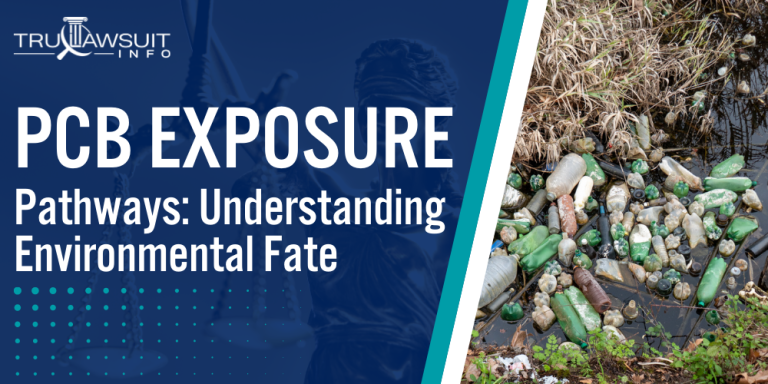
Intro to PCB Exposure
Some of the key aspects of PCB exposure include, but are not limited to:
- Routes of Exposure: PCB exposure can occur through inhalation, ingestion, or dermal contact with contaminated materials or food sources.
- Health Effects: PCB exposure has been linked to a range of adverse health effects, including cancer, reproductive and developmental disorders, and immune system dysfunction.
- Vulnerable Populations: Certain groups, such as pregnant women, children, and individuals with high fish consumption, may be at higher risk of PCB exposure and its associated health effects.
- Exposure Assessment: Assessing the extent and sources of PCB exposure is crucial for developing strategies to minimize health risks and guide public health interventions.
If you suspect that you or your community may be at risk of PCB exposure, it is essential to assess your exposure levels.
Contact TruLawsuit Info today using the chat on this page to determine if you qualify to file in the PCB lawsuit.
Table of Contents
Overview of PCB Exposure Pathways
On this page, we’ll discuss an overview of PCB exposure pathways, the intricacies of polychlorinated biphenyls (PCBs), strategies to mitigate exposure to PCBs, and their impact on public health.
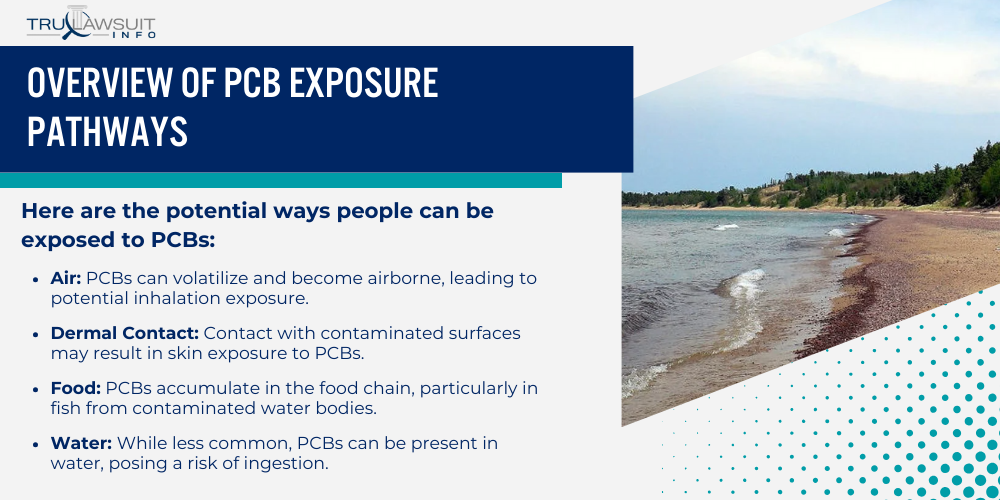
Intro to PCB Exposure Pathways
Polychlorinated Biphenyls (PCBs) are synthetic chemicals widely used in manufacturing.
Despite being banned in many countries since the 1970s, PCB exposure remains a concern due to its environmental persistence and potential health impacts.
Here are the potential ways people can be exposed to PCBs:
- Air: PCBs can volatilize and become airborne, leading to potential inhalation exposure.
- Dermal Contact: Contact with contaminated surfaces may result in skin exposure to PCBs.
- Food: PCBs accumulate in the food chain, particularly in fish from contaminated water bodies.
- Water: While less common, PCBs can be present in water, posing a risk of ingestion.
Protecting public health requires ongoing monitoring and mitigation of these exposure pathways.
Atmospheric Transport and Deposition of PCB Pollutants
Polychlorinated Biphenyls (PCBs) are toxic substances that, when released into the environment, can travel through the air over great distances before being deposited far from their source, affecting environmental health perspectives and the quality of the breathing air.
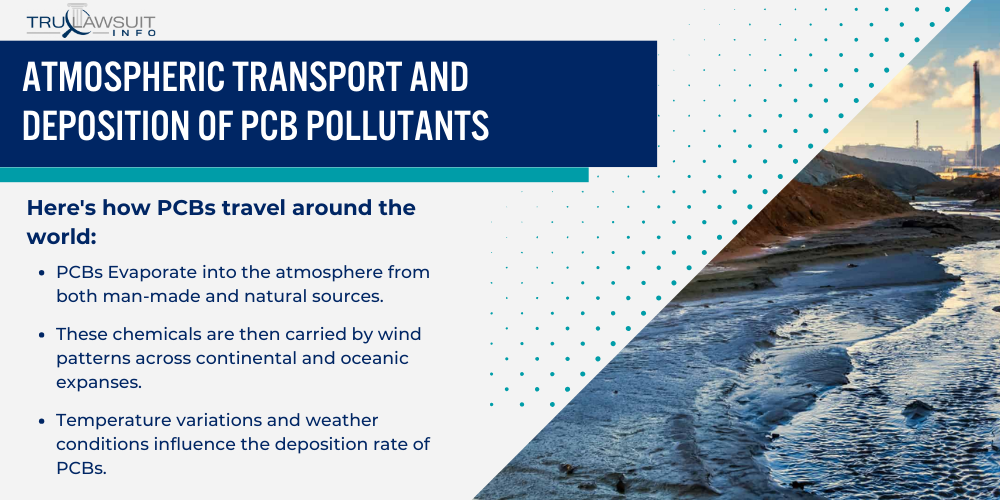
Examining Global Distribution of PCBs via Air Currents
The global distribution of PCBs is facilitated by their volatility and persistence.
Here’s how PCBs travel around the world:
- PCBs Evaporate into the atmosphere from both man-made and natural sources.
- These chemicals are then carried by wind patterns across continental and oceanic expanses.
- Temperature variations and weather conditions influence the deposition rate of PCBs.
- Over time, repeated cycles of evaporation and deposition result in a diffuse spreading of these pollutants globally.
Local PCB Exposure Risks from Atmospheric Deposition
PCBs are man-made chemicals that were once popular but are now banned because they harm health.
They are long-lasting and can travel through the air, posing exposure risks in areas affected by atmospheric deposition.
Here’s how atmospheric deposition can lead to local PCB exposure:
- Atmospheric deposition occurs when PCBs in the air settle onto land or water surfaces.
- This process can destroy local ecosystems, exposing wildlife and humans to toxic effects.
- Particular concern arises in urban areas where industrial emissions contribute significantly to local PCB levels.
- Precipitation patterns, such as rainfall or snow, can increase the deposition of PCBs locally, heightening health risks.
Water Bodies as Critical Conduits for PCB Exposure
The pervasive presence of PCBs in aquatic environments highlights the risk of exposure through water-based ecosystems.
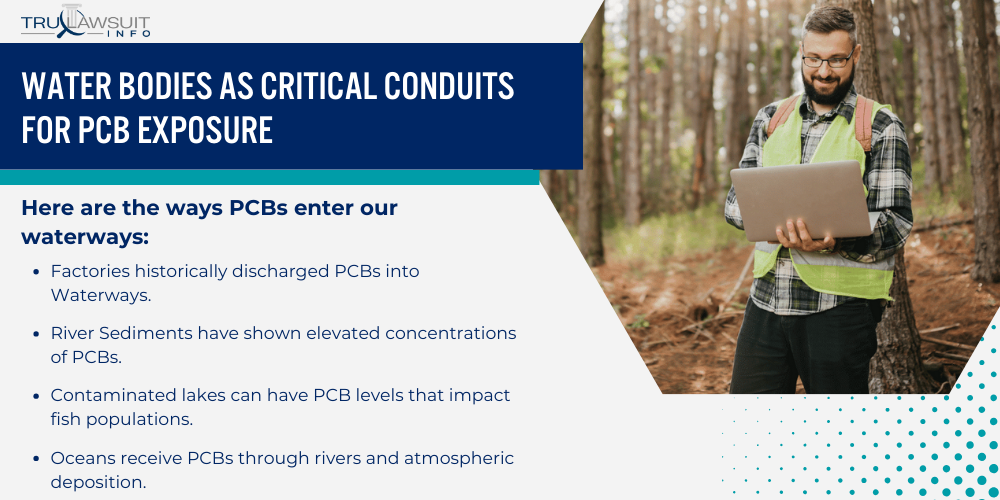
These chemical contaminants significantly threaten wildlife and human health, primarily through consuming contaminated seafood.
PCB Contamination in Rivers, Lakes, and Oceans
Due to industrial discharges and runoff, rivers, lakes, and oceans have become repositories for PCBs.
Contaminated water bodies often serve as direct sources of PCBs for aquatic organisms.
Here are the ways PCBs enter our waterways:
- Factories historically discharged PCBs into Waterways.
- River Sediments have shown elevated concentrations of PCBs.
- Contaminated lakes can have PCB levels that impact fish populations.
- Oceans receive PCBs through rivers and atmospheric deposition.
Research suggests that PCB contamination has measurable impacts on the health of ecosystems within these waters.
For instance, studies listed by the U.S. EPA ARCHIVE DOCUMENT indicate that PCB contamination has compromised marine species.
Aquatic Food Webs: Bioaccumulation & Biomagnification
The danger of PCBs lies in their persistence and how they move through the food chain.
Let’s explore how PCBs accumulate and magnify in aquatic ecosystems:
- Bioaccumulation occurs when organisms take up PCBs at a rate faster than they can be eliminated.
- These toxins accumulate in the fat tissues of organisms.
- Biomagnification takes place when PCB concentrations increase at each trophic level.
- Top predators, including humans eating contaminated fish, are at greater risk.
Consuming PCB-contaminated fish is a primary concern for human populations.
According to the Public Health Statement | ATSDR, PCB exposure can lead to significant health issues, reinforcing the need for ongoing surveillance and control measures on the water bodies that serve as pathways for these chemicals to enter the food web.
Soil and Sediment: Reservoirs for Persistent PCB Exposure
Polychlorinated Biphenyls (PCBs) are persistent organic pollutants that heavily bind to soil and sediment particles.
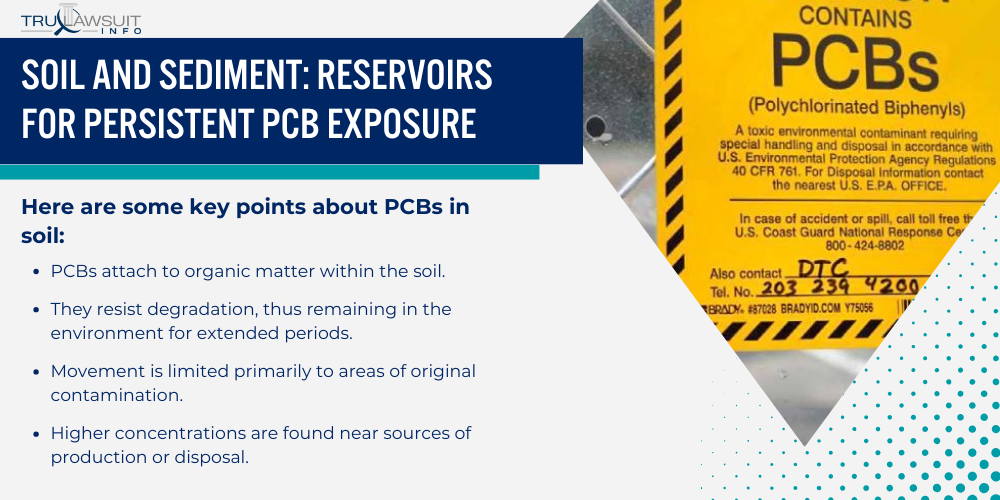
These contaminants pose a long-term environmental threat, particularly at hazardous waste sites where past industrial activities have left a legacy of pollution.
PCBs Adhering to Soil Particles and River/Lake Sediments
PCBs have a high affinity for soil and sediments due to their low solubility in water and stable chemical structure.
Over decades, sediments can act as reservoirs for these chemicals, slowly releasing them back into the environment.
PCBs in Soil
Here are some key points about PCBs in soil:
- PCBs attach to organic matter within the soil.
- They resist degradation, thus remaining in the environment for extended periods.
- Movement is limited primarily to areas of original contamination.
- Higher concentrations are found near sources of production or disposal.
PCBs in Sediments
Here are some key points about PCBs in sediments:
- Tend to accumulate in river and lake beds.
- It can be disturbed by natural processes or human activities, causing secondary contamination.
- Concentrations vary depending on proximity to pollution sources.
- Sediment-bound PCBs can enter the food chain, affecting aquatic life and predators.
Uptake of PCBs into Plants and Soil Microbial Communities
Plants and microorganisms in the soil can absorb and accumulate PCBs, leading to wider ecological impacts and human exposure risks throughout the food chain.
Plant Uptake of PCBs:
- Root absorption can result in PCB presence in plant tissues.
- The level of uptake varies depending on the type and concentration of PCBs in the soil.
- Plants grown in contaminated sites, like some hazardous waste areas, can contain significant PCB levels.
- The transfer of PCBs into agricultural products is a concern for food safety.
Impact of PCBs on Soil Microbes:
- PCBs may inhibit microbial activity and diversity in the soil.
- Some microbes can metabolize certain PCB compounds, albeit very slowly.
- Applying commercial PCB mixtures such as Aroclor has a long-term impact on soil microbial health.
- Bioremediation strategies are being researched to utilize microbes for PCB degradation.
Wildlife and Livestock: Understanding Animal PCB Exposure
Polychlorinated Biphenyls (PCBs) are persistent pollutants that accumulate in animal fat tissues.
PCBs affect wildlife and livestock and potentially human health throughout the food chain.
PCB Exposure Pathways for Fish, Birds, and Mammals
PCBs enter various ecosystems, leading to exposure pathways for fish, birds, and mammals.
- Fish: PCBs enter aquatic systems through industrial discharge and contaminated runoff.
They accumulate in the fatty tissues of fish, often significantly marking predator species higher up the food chain.
- Birds: Consumption of contaminated fish and invertebrates can lead to PCB accumulation in birds, particularly those higher up the food chain, such as eagles and ospreys.
- Mammals: Terrestrial mammals can be exposed by ingesting contaminated plants and prey species.
Marine mammals are exposed primarily through their diet of fish and squid.
Understanding these exposure pathways is vital for assessing PCB levels in wildlife and the implications for both animal and human health.
Food Animal PCB Contamination and Human Exposure Risks
Contamination of food animals poses direct hazards to human health.
Pathways of PCB Exposure from Food Animals:
- Body Fat: PCBs concentrate in animal fat and may enter the human diet by consuming meat and dairy products.
- Breast Milk: PCBs can be transferred to infants through breast milk due to their accumulation in nursing mothers’ body fat.
- Bioaccumulation: Over time, PCBs bioaccumulate in the food chain, exposing humans to higher levels through consuming affected livestock and fish.
- Monitoring: Regular inspections and control measures are implemented to ensure that PCB levels in food animals remain within safe limits.
Human PCB Exposure Routes: Diet, Inhalation, Skin Contact
Polychlorinated Biphenyls (PCBs) are industrial chemicals once widely used in electrical apparatuses that have pervaded the environment, leading to various human exposure routes.
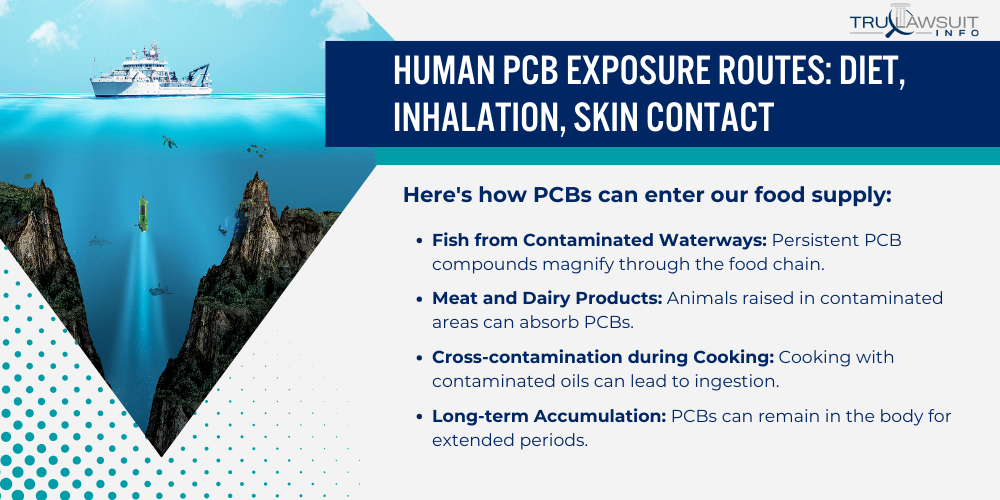
These chemicals have been linked to adverse health effects, including impacts on the immune system and an increased risk for certain cancers.
Ingestion of PCB-Tainted Food as Primary Exposure Pathway
Eating contaminated food is the main way people are exposed to PCBs.
These chemicals can accumulate in animal fat.
Here’s how PCBs can enter our food supply:
- Fish from Contaminated Waterways: Persistent PCB compounds magnify through the food chain.
- Meat and Dairy Products: Animals raised in contaminated areas can absorb PCBs.
- Cross-contamination during Cooking: Cooking with contaminated oils can lead to ingestion.
- Long-term Accumulation: PCBs can remain in the body for extended periods.
Due to their classification as probable human carcinogens by the International Agency, there is significant concern over the ingestion of PCBs and the subsequent risk for liver cancer and breast cancer.
Assessing Inhalation and Dermal Contact Exposure to PCBs
Inhalation and skin contact are additional, though less prominent, exposure pathways.
Here are the potential scenarios for inhalation and dermal contact exposure to PCBs:
- Exposure in the Workplace: Exposed Workers may inadvertently inhale PCB vapors or come into contact with oily liquids.
- Improperly Maintained Older Electrical Devices: Old Fluorescent Lighting Fixtures can release PCBs into the environment.
- Accidents Involving PCB Disposal Facilities: Spills or leaks can lead to inhalation of PCBs.
- Handling of Hydraulic Oils: Industries still using hydraulic oils may expose workers to PCBs through the air or direct contact.
While the general public’s risk through inhalation and skin contact is lower, individuals, especially those with occupational exposure, should be aware of the potential health implications, including thyroid hormone disruption and liver damage.
Modeling Techniques for Predicting PCB Environmental Fate
Predicting the environmental destiny of polychlorinated biphenyls (PCBs) requires sophisticated modeling techniques.
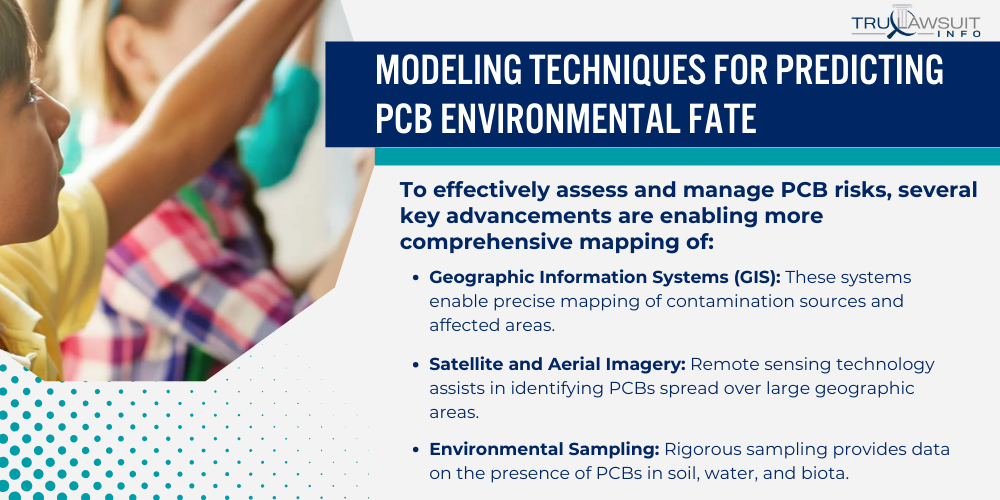
These techniques help understand how PCBs spread through the environment and affect human health.
The Environmental Protection Agency (EPA) and other entities, such as the National Toxicology Program, use these models to assess the impact of PCB mixtures in various ecosystems.
Advances in Mapping PCB Sources, Transport, and Exposure
Maintaining PCBs’ sources, transport mechanisms, and exposure levels is crucial for environmental health.
To effectively assess and manage PCB risks, several key advancements are enabling more comprehensive mapping of:
- Geographic Information Systems (GIS): These systems enable precise mapping of contamination sources and affected areas.
- Satellite and Aerial Imagery: Remote sensing technology assists in identifying PCBs spread over large geographic areas.
- Environmental Sampling: Rigorous sampling provides data on the presence of PCBs in soil, water, and biota.
- Data from Disease Registry: Utilized to correlate exposure data with health outcomes.
These advancements facilitate a deeper understanding of PCB dynamics and pinpoint populations at higher risk of exposure.
Strategies for Preventing and Mitigating PCB Exposures
Mitigating exposure to PCBs is vital for protecting public health and the environment.
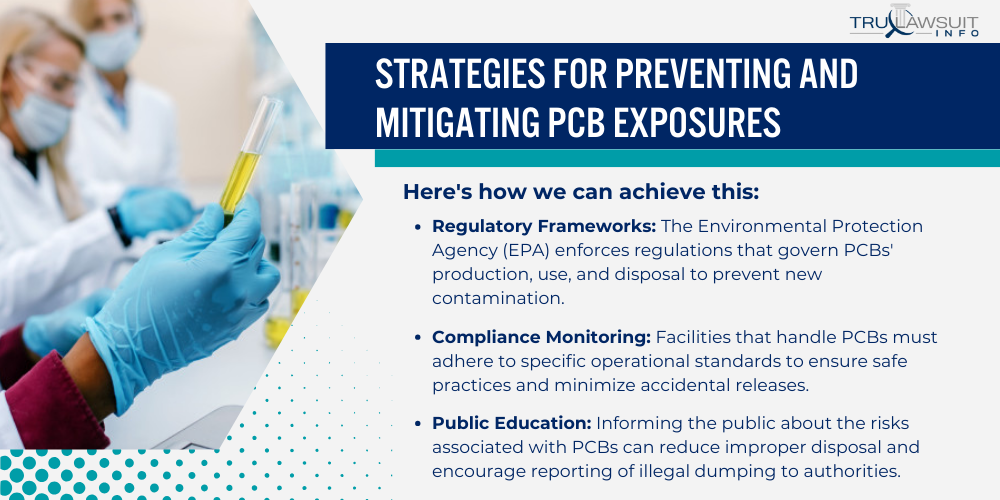
Effective strategies involve preventing PCB releases and managing contamination through nuanced approaches.
Policies and Practices to Reduce PCB Releases & Spread
Strict policies and vigilant practices are key to curtail the release of PCBs.
Here’s how we can achieve this:
- Regulatory Frameworks: The Environmental Protection Agency (EPA) enforces regulations that govern PCBs’ production, use, and disposal to prevent new contamination.
- Compliance Monitoring: Facilities that handle PCBs must adhere to specific operational standards to ensure safe practices and minimize accidental releases.
- Public Education: Informing the public about the risks associated with PCBs can reduce improper disposal and encourage reporting of illegal dumping to authorities.
- Cleanup Protocols: Establishing clear protocols for cleaning up PCB spills quickly and effectively can limit their environmental spread.
Remediation Efforts to Interrupt Environmental Exposure Pathways
Interrupting the pathways through which PCBs enter the environment and reach humans or wildlife requires a focused remediation effort.
Here’s a multi-pronged approach to achieve this:
- Site Assessments: Identifying hazardous waste sites with PCB contamination is an essential first step in commencing cleanup operations.
- Removal Actions: Safely removing contaminated soil or sediments from affected sites helps reduce the potential for PCB exposure.
- Containment Measures: In some cases, containing the area with a barrier can prevent the migration of PCBs until a full cleanup is feasible.
- Long-term Monitoring: Post-remediation monitoring ensures that PCB levels remain low, protecting public health and ecosystems from future risks.
Frequently Asked Questions
-
What Are the Common Symptoms Associated with PCB Exposure?
Individuals who have been exposed to PCBs may experience a range of symptoms.
Skin conditions such as chloracne, a severe form of acne, are often reported, as well as eye irritation and a discharge from the eyes.
-
Through What Means Can Humans Become Exposed to PCBs?
Humans can be exposed to PCBs through several routes, including consuming contaminated food, especially fish, inhaling air-containing PCBs, and skin contact with materials that contain PCBs, like old electrical equipment such as PCB capacitors.
-
What Are the Potential Health Effects of Exposure to PCBs?
Exposure to PCBs may lead to several adverse health effects.
Some of these include neurobehavioral and immunological changes in children, an increased risk of cancer, and other effects such as reproductive and developmental problems.
-
What Are the Recommended Exposure Limits for PCBs?
Regulatory agencies have set guidelines to limit exposure to PCBs, striving to maintain levels as low as possible.
The Environmental Protection Agency establishes safe levels, calculated based on the latest scientific evidence, to minimize the risks associated with PCB exposure.
-
What Treatments Are Available for People Who Have Been Exposed to PCBs?
Currently, there is no specific treatment for eliminating PCBs from the body.
The approach primarily involves supportive care, with strategies to relieve symptoms and prevent further exposure.
-
How Can One Test for PCB Levels in the Body?
Testing for PCB levels can involve blood tests or adipose tissue biopsies.
Make sure to consult with healthcare professionals to interpret these tests.
PCB levels in the body can reflect both recent and past exposures.

Experienced Attorney & Legal SaaS CEO
With over 25 years of legal experience, Jessie is an Illinois lawyer, a CPA, and a mother of three. She spent the first decade of her career working as an international tax attorney at Deloitte.
In 2009, Jessie co-founded her own law firm with her husband – which has scaled to over 30 employees since its conception.
In 2016, Jessie founded TruLaw, which allows her to collaborate with attorneys and legal experts across the United States on a daily basis. This hypervaluable network of experts is what enables her to share reliable legal information with her readers!
Have A Case?
Here, at Tru Lawsuit Info, we’re committed to helping victims get the justice they deserve.
To do this, we actively work to connect them with attorneys who are experts in litigating cases similar to theirs.
Would you like our help?
Tru Lawsuit Info is a reliable source of information about issues that may affect your health and safety, such as faulty products, data breaches, and environmental hazards.
Our team of experienced writers collaborates with medical professionals, lawyers, and advocates to produce informative articles, guides, and other resources that raise awareness of these topics.
Our thorough research provides consumers with access to reliable information and updates on lawsuits happening around the country. We also can connect consumers with attorneys if they need assistance.
Camp Lejeune's water contamination issue spanned several decades starting in the 1950s. Exposure to these chemicals has been linked to various serious health issues, including cancer, organ diseases, and death.
Research is increasingly suggesting a link between the use of Tylenol during pregnancy and the development of neurodevelopmental disorders, such as autism and ADHD, in infants.
Legal action is being taken against manufacturers of Aqueous Film-Forming Foam (AFFF), a chemical used in fighting fires. The plaintiffs allege that exposure to the foam caused health issues such as cancer, organ damage, and birth and fertility issues.
Have A Case?
Here, at Tru Lawsuit Info, we’re committed to helping victims get the justice they deserve.
To do this, we actively work to connect them with attorneys who are experts in litigating cases similar to theirs.
Would you like our help?







